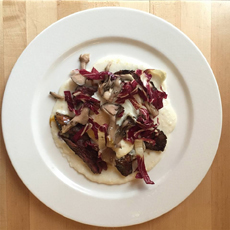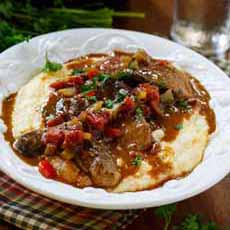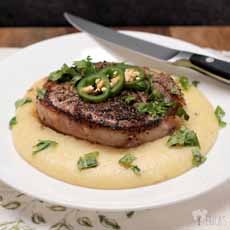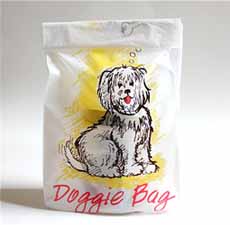Leftover Steak For Breakfast & The History Of The Doggie Bag
|
When life gives you leftover steak, make steak and grits. That’s what we did when we happily brought home a doggie bag from a midtown steakhouse Friday night. The next morning the leftovers became part of breakfast (or brunch*, if you prefer). You can make steak and eggs, of course; but we don’t have grits often enough. And there’s no reason why you can’t combine all three, as in photo #3. We were inspired by this photo from Publican Quality Meats of Chicago to recreate a version of their recipe with mushrooms, radicchio and parmesan cheese (photo #1). You can go as plain or fancy as you like. The ingredients can be cooked up to two days in advance, then assembled and heated. This is especially great news for those who demand the best, creamiest grits, which can take 90 minutes cooking time. 1. COOK the grits per the package instructions. While the grits are cooking… 2. SLICE the steak and place it in a microwave-safe dish. 3. SAUTÉ the radicchio and mushrooms, stirring occasionally, 4 to 5 minutes. When ready, warm the steak in the microwave. 4. SPOON the grits onto plates and arrange the sliced steak, radicchio and mushrooms. Garnish as desired with freshly-shaved Parmesan cheese. Serve with a pepper mill. Since Elizabethan times at least, taverns and public houses provided extra-large napkins—not only because people ate with their hands, but they used them to wrap up and take home any leftovers. Long before then, well-to-do ancients were accustomed to bringing napkins when invited to dinner, initially to clean one’s hands and mouth. Hosts provided the food, but not the linens. Around the 6th century B.C.E., they started using their napkins to wrap leftovers to take home (here’s the history of the napkin). It was also common practice to distribute leftovers to vassals, slaves and servants; and since there was no refrigeration, remnants went to dogs and pigs. In postwar times (that’s post-World War II), customers of steak houses would ask to take home the meaty leftovers, “for the dog.” (For those with no dog, it became a decorous way of taking the food home, for people accustomed to the frugal practices of wartime rationing.) There are different claims to the origin of the doggie bag: In 1949, Al Meister, owner of Bagcraft Papercon, a Chicago-based packaging company, developed a coated paper bag that was grease-resistant. He is credited with inventing the “doggie bag”—and the take-out bag, for that matter. See the footnote† below for other references. Grease-resistant bags soon evolved into foil-lined bags with drawings of Fido—a way to explain why nice people were leaving the restaurant with paper bags. Yet elsewhere, many people were criticized by embarrassed family and friends with whom they dined, who felt it was in poor taste. According to one article, well into the 1970s etiquette columns in newspapers got letters asking if it was O.K. to ask for a doggie bag if they didn’t have a dog. |
 [1] Turn leftover steak into steak and grits, here topped with radicchio (photo © Publican Quality Meats| Chicago).
|
|
|
With the exception of Elizabeth Post, Emily Post’s granddaughter by marriage, advice columnists invariably approved of doggie bags as “sensible if not downright virtuous.” That remains on trend. No one wants to throw out good food, including the restaurants. (Seattle has even enacted laws to create less kitchen food waste.) So no matter how large or small the amount of leftover food, don’t hesitate ask for it. If not, you’ll wake up the next day, sorry you didn’t take it home. ________________ *Breakfast is the first meal of the day, lunch is the second meal, after breakfast. “Brunch” evolved as a weekend meal for later risers, who combined the two meals. Brunch is typically eaten during the late morning or early afternoon and can include both conventional breakfast items (eggs, pancakes) and lunch items (frittatas, starts, quiche, soup and salad, panini or other lighter fare). The other benefit of brunch over breakfast: cocktails with juice (Bellini, Bloody Mary, Mimosa, etc.) †Sources vary as to the origin of the term: >According to the Encyclopedia of American Food and Drink, John F. Mariani [Lebhar Friedman:New York] 1999 (p. 113): “Although leftovers have long been packed up for customers, the term ‘doggie bag’ dates in print to 1963. Two claims have been made for the idea under that name, Lawry’s Prime Rib, a Los Angeles restaurant that dates it usage back to the 1930s, and the Old Homestead Steak House in New York City, whose owner, Harry Sherry, also began to use the term in the 1930s.” >According to Oxford Companion to Food, Alan Davidson [Oxford University Press:Oxford] 2nd edition, 2007 (p. 253), notes that the doggy bag (or doggie bag) presumed the dog to be the beneficiary of the contents. A 1943 print reference notes that in San Francisco and Seattle, a bag called the Pet Packit was used to take home leftovers. >Restaurants in San Francisco and Seattle started to providing waxed paper bags for customers to take home leftovers “for the dog”; the custom rolled out nationwide. >Yet another claim says that the doggie bag was born in 1949 at Dan Stampler’s Steak Joint on Greenwich Avenue in New York City. Their grease-proof doggie bags bore an image of the proprietor’s Scottish terrier. They were manufactured by Bagcraft Corporation of Chicago, which sold them to other restaurants as well. Subsequently, the wife of the co-founder of Bagcraft, Jane Meister, wrote a poem that appeared on the bags: “Oh where, oh where have your leftovers gone? / Oh where, oh where can they be? / If you’ve had all you can possibly eat,/ Please bring the rest home to me!!” For more information see the article in Smithsonian Magazine.
|
||






